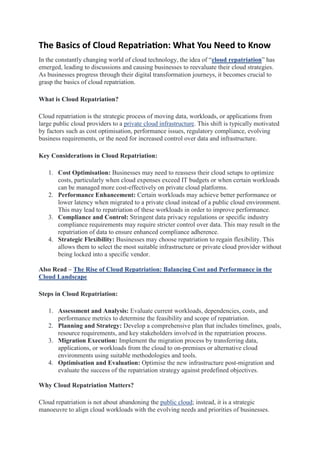The Basics of Cloud Repatriation: What You Need to Know
•Download as DOCX, PDF•
1 like•5 views
Curious about cloud repatriation? Uncover the essentials and key insights in our latest blog. Dive into strategies for successful workload transition.
Report
Share
Report
Share

Recommended
Recommended
This jointly authored white paper examines how organizations are confronting
the challenges of integrating cloud-based services into a traditional managed
services model. General considerations around industry- and company specific
objectives are outlined, and case studies are used to illustrate a range
of scenarios, strategies and benefits achieved.Adding Cloud to the Service Delivery Mix: Business Drivers and Organizational...

Adding Cloud to the Service Delivery Mix: Business Drivers and Organizational...Information Services Group (ISG)
More Related Content
Similar to The Basics of Cloud Repatriation: What You Need to Know
This jointly authored white paper examines how organizations are confronting
the challenges of integrating cloud-based services into a traditional managed
services model. General considerations around industry- and company specific
objectives are outlined, and case studies are used to illustrate a range
of scenarios, strategies and benefits achieved.Adding Cloud to the Service Delivery Mix: Business Drivers and Organizational...

Adding Cloud to the Service Delivery Mix: Business Drivers and Organizational...Information Services Group (ISG)
Similar to The Basics of Cloud Repatriation: What You Need to Know (20)
Adding Cloud to the Service Delivery Mix: Business Drivers and Organizational...

Adding Cloud to the Service Delivery Mix: Business Drivers and Organizational...
Essential Components of a Successful Cloud Migration Strategy

Essential Components of a Successful Cloud Migration Strategy
navigating the cloud key considerations for cloud computing solutions.pdf

navigating the cloud key considerations for cloud computing solutions.pdf
Recently uploaded
Recently uploaded (20)
AI+A11Y 11MAY2024 HYDERBAD GAAD 2024 - HelloA11Y (11 May 2024)

AI+A11Y 11MAY2024 HYDERBAD GAAD 2024 - HelloA11Y (11 May 2024)
Six Myths about Ontologies: The Basics of Formal Ontology

Six Myths about Ontologies: The Basics of Formal Ontology
Microsoft CSP Briefing Pre-Engagement - Questionnaire

Microsoft CSP Briefing Pre-Engagement - Questionnaire
Event-Driven Architecture Masterclass: Challenges in Stream Processing

Event-Driven Architecture Masterclass: Challenges in Stream Processing
The Zero-ETL Approach: Enhancing Data Agility and Insight

The Zero-ETL Approach: Enhancing Data Agility and Insight
Portal Kombat : extension du réseau de propagande russe

Portal Kombat : extension du réseau de propagande russe
Navigating the Large Language Model choices_Ravi Daparthi

Navigating the Large Language Model choices_Ravi Daparthi
How to Check CNIC Information Online with Pakdata cf

How to Check CNIC Information Online with Pakdata cf
ChatGPT and Beyond - Elevating DevOps Productivity

ChatGPT and Beyond - Elevating DevOps Productivity
Easier, Faster, and More Powerful – Alles Neu macht der Mai -Wir durchleuchte...

Easier, Faster, and More Powerful – Alles Neu macht der Mai -Wir durchleuchte...
WebRTC and SIP not just audio and video @ OpenSIPS 2024

WebRTC and SIP not just audio and video @ OpenSIPS 2024
The Basics of Cloud Repatriation: What You Need to Know
- 1. The Basics of Cloud Repatriation: What You Need to Know In the constantly changing world of cloud technology, the idea of “cloud repatriation” has emerged, leading to discussions and causing businesses to reevaluate their cloud strategies. As businesses progress through their digital transformation journeys, it becomes crucial to grasp the basics of cloud repatriation. What is Cloud Repatriation? Cloud repatriation is the strategic process of moving data, workloads, or applications from large public cloud providers to a private cloud infrastructure. This shift is typically motivated by factors such as cost optimisation, performance issues, regulatory compliance, evolving business requirements, or the need for increased control over data and infrastructure. Key Considerations in Cloud Repatriation: 1. Cost Optimisation: Businesses may need to reassess their cloud setups to optimize costs, particularly when cloud expenses exceed IT budgets or when certain workloads can be managed more cost-effectively on private cloud platforms. 2. Performance Enhancement: Certain workloads may achieve better performance or lower latency when migrated to a private cloud instead of a public cloud environment. This may lead to repatriation of these workloads in order to improve performance. 3. Compliance and Control: Stringent data privacy regulations or specific industry compliance requirements may require stricter control over data. This may result in the repatriation of data to ensure enhanced compliance adherence. 4. Strategic Flexibility: Businesses may choose repatriation to regain flexibility. This allows them to select the most suitable infrastructure or private cloud provider without being locked into a specific vendor. Also Read – The Rise of Cloud Repatriation: Balancing Cost and Performance in the Cloud Landscape Steps in Cloud Repatriation: 1. Assessment and Analysis: Evaluate current workloads, dependencies, costs, and performance metrics to determine the feasibility and scope of repatriation. 2. Planning and Strategy: Develop a comprehensive plan that includes timelines, goals, resource requirements, and key stakeholders involved in the repatriation process. 3. Migration Execution: Implement the migration process by transferring data, applications, or workloads from the cloud to on-premises or alternative cloud environments using suitable methodologies and tools. 4. Optimisation and Evaluation: Optimise the new infrastructure post-migration and evaluate the success of the repatriation strategy against predefined objectives. Why Cloud Repatriation Matters? Cloud repatriation is not about abandoning the public cloud; instead, it is a strategic manoeuvre to align cloud workloads with the evolving needs and priorities of businesses.
- 2. Understanding the basics of cloud repatriation empowers organisations to make informed decisions regarding their cloud strategy. This ensures an optimal balance between cost, performance, compliance, and control. Conclusion: Cloud repatriation is a nuanced strategy requiring careful evaluation, planning, and execution. It offers businesses the flexibility to realign their cloud assets according to changing requirements while optimising costs and enhancing performance. At Apiculus, we understand the intricacies of cloud strategy. Stay tuned for more insights on cloud repatriation and other crucial aspects of cloud technology.